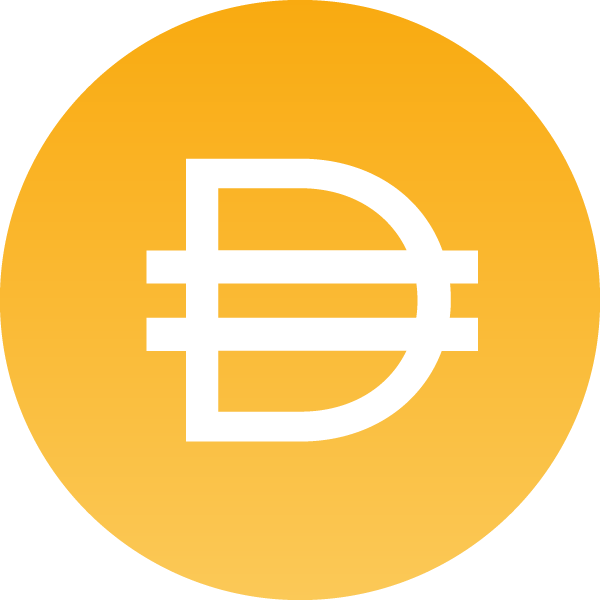
Dai Price (DAI)

Past performance is not a reliable indicator of future results. Learn more about asset risks.
Investment Risk
Market stats
Dai is on the decline this week. ↘
The current price is £0.81 per DAI with a 24-hour trading volume of £182.10M. Currently, Dai is valued at 26.84% below its all time high of £1.11. This all-time high was the highest price paid for Dai since its launch.
The current circulating supply of Dai is 5,365,382,702.665 DAI which means that Dai has as total market cap of 5,365,382,702.665.
Overall
Market cap
£4.3B
Volume (24h)
£182.1M
Circulating
5.4B DAI
Hold time
8 days
Popularity
#30
All time high
£1.11
Past performance is not a reliable indicator of future results. Learn more about asset risks.
This data was sourced in real-time from Coinbase and other third party market vendors. Real-time data may encounter temporary delays due to system performance or downtime.
Price change
1 hour
0%
1 day
0%
1 week
↘ 0.01%
2 weeks
↗ 1.22%
1 month
↘ 0.01%
1 year
↗ 0.01%
Past performance is not a reliable indicator of future results. Learn more about asset risks.
This data was sourced in real-time from Coinbase and other third party market vendors. Real-time data may encounter temporary delays due to system performance or downtime.
About Dai
Dai (DAI) is a decentralized stablecoin running on Ethereum (ETH) that attempts to maintain a value of $1.00 USD. Unlike centralized stablecoins, Dai isn't backed by US dollars in a bank account. Instead, it’s backed by collateral on the Maker platform. Note: if the Dai credit system is upgraded or shutdown, Dai holders may need to convert their Dai to Ethereum through the Maker platform. Read more at makerdao.com/whitepaper.
FAQ
Dai is a stablecoin that is stabilized against the value of the US dollar. A stablecoin is a digital currency that is pegged to a “stable” reserve asset like the U.S. dollar or gold. Stablecoins are designed to reduce volatility relative to unpegged cryptocurrencies like Bitcoin. Running on Ethereum blockchain, MakerDAOProtocol created the Dai token. The token is a decentralized collateral-backed stablecoin that intends to keep its value near or equal to $1.
One major roadblock in the mainstream adoption of cryptocurrencies for transactions is high volatility. Nobody wants to pay with a currency that has the potential of doubling its value in a short time or wants to be paid in a currency that can lose value significantly. This problem has led to the birth of many stablecoins like Dai. The whitepaper suggests that MakerDAO aims to solve these problems and bring stability to the cryptocurrency economy and believes a stablecoin is essential for any business to realize the advantages of digital currency.
Stablecoins aim to provide many inherent benefits to the cryptocurrency ecosystem, like secured transactions, lower fees, quick settlements, and instant transfer. They can offer a stable value during times of volatility in the markets. Furthermore, they can be used as a stable and reliable cryptocurrency for global payments and sent in large amounts to anyone with a wallet.
For Dai to maintain a stable value of $1, the Maker protocol implements game theory. The protocol smartly maintains and balances the economic incentives to constantly keep the value of Dai near $1. Whenever the value of Dai goes below $1, the protocol incentivizes users to increase the price. On the contrary, if and when the value of Dai goes above $1, the incentives work the other way around.
Talking about the token, Dai is an ERC-20 token that aims to be easy to generate, access, and use. The token is backed by collateral assets that are deposited into the Maker vault of the protocol. As illustrated in the whitepaper, the Dai token, like traditional currencies, has certain benefits: since the token aims to have a stable value, for example, 1 Dai = $1, it can be used for exchange and can be used to settle debts and deferred payments. Therefore, it can be said that Dai has functionality similar to a traditional currency.
MakerDAO launched Dai stablecoin in December 2017. MakerDAO was created in 2015 by Rune Christensen.
Rune Christensen is an entrepreneur from Sealand, Denmark. Before MakerDAO, Christensen studied international business and biochemistry in Copenhagen. He was also the cofounder of the Try-China International recruiting company.
The Maker protocol only considered ETH as collateral for Dai during its inception. However, the technology got upgraded to include BAT and USDC in November 2019. Subsequently, the Dai system became multicollateral, using different cryptocurrencies as collateral.
The MakerDAO protocol easily creates new Dai tokens. As already discussed, Dai is a collateral-backed asset where the collateral is stored in Maker vaults. Once users deposit the collateral assets into Maker vaults, the protocol issues new Dai tokens. The user can easily gain access to the liquidity, and new Dai tokens are entered into circulation.
Further, the whitepaper suggests that Dai tokens may be staked through the Dai Saving Rate (DSR) protocol. The DSR is a native smart contract that runs on the MakerDAO system. Dai tokens can be locked into a DSR contract, enabling the users to earn yield at the current rate. The additional benefits that DSR provides for Dai staking are the ability to withdraw Dai tokens at any point in time and no minimum staking requirement.
The maximum number of Dai tokens is not fixed and is volatile. However, as of the writing of this article (January 19, 2022), there are a total of 9.7 billion Dai tokens issued.
Coinbase Exchange is currently one of the active exchanges for Dai trading. Coinbase is a user-friendly platform that offers a secure way to trade Dai.
We update our Dai to GBP currency in real-time. Get the live price of Dai on Coinbase.
The current market cap of Dai is £4.35B. A high market cap implies that the asset is highly valued by the market.
The all-time high of Dai is £1.11. This all-time high is highest price paid for Dai since it was launched.
Over the last 24 hours, the trading volume of Dai is £182.10M.
Assets that have a similar market cap to Dai include Chainlink, Polkadot, Polygon, and many others. To see a full list, see our comparable market cap assets.
The current circulating supply of Dai is 5.4 billion.
The median time that Coinbase customers hold Dai before selling it or sending it to another account or address is 8 days.
Dai ranks 64 among tradable assets on Coinbase. Popularity is currently based on relative market cap.
Currently, 97% of Coinbase users are buying Dai. In other words, 97% of Coinbase customers have increased their net position in Dai over the past 24 hours through trading.
Yes, Dai is currently available on Coinbase’s centralized exchange. For more detailed instructions, check out our helpful how to buy Dai guide.
Dai Price History
Date | Price | Change |
|---|---|---|
Today (January 22, 2025) | £0.81 | 0.00% |
24 hours ago (January 21, 2025) | £0.81 | 0.00% |
1 week ago (January 15, 2025) | £0.82 | -0.01% |
1 month ago (December 22, 2024) | £0.80 | -0.01% |
1 year ago | £0.79 | 0.01% |
Get up to $200 for getting started
Earn free crypto after making your first purchase. Terms apply.

Sum of median estimated savings and rewards earned, per user in 2021 across multiple Coinbase programs (excluding sweepstakes). This amount includes fee waivers from Coinbase One (excluding the subscription cost), rewards from Coinbase Card, and staking rewards.
Dai Calculator
Social
Some highlights about Dai on social media
192 unique individuals are talking about Dai and it is ranked #499 in most mentions and activity from collected posts. In the last 24 hours, across all social media platforms, Dai has an average sentiment score of 3.4 out of 5. Finally, Dai is becoming more newsworthy, with 0 news articles published about Dai. This is a 0% increase in news volume compared to yesterday.
On Twitter, people are mostly bullish about Dai. There were 66.67% of tweets with bullish sentiment compared to 2.44% of tweets with a bearish sentiment about Dai. 30.89% of tweets were neutral about Dai. These sentiments are based on 123 tweets.
On Reddit, Dai was mentioned in 2 Reddit posts and there were 6 comments about Dai. On average, there were more upvotes compared to downvotes on Reddit posts and more upvotes compared to downvotes on Reddit comments.
Powered by LunarCrush
Overview
Contributors
192 people
Posts
121 posts
Dominance
0%
Volume rank
#499
Average Sentiment
3.4 out of 5
Tweet Count
123 people
Sentiment
66.67%
Bullish
30.89%
Neutral
2.44%
Bearish
Related Assets
Discover conversions
Popular cryptocurrencies
A selection of cryptocurrencies in the top 50 by market cap.
Comparable market cap
Of all the assets on Coinbase, these 12 are the closest to Dai in market cap.
Discover more assets
A selection of other relevant cryptocurrencies
This data was sourced in real-time from Coinbase and other third party market vendors. Real-time data may encounter temporary delays due to system performance or downtime.
Certain content has been prepared by third parties not affiliated with Coinbase Inc. or any of its affiliates and Coinbase is not responsible for such content. Coinbase is not liable for any errors or delays in content, or for any actions taken in reliance on any content. Information is provided for informational purposes only and is not investment advice. This is not a recommendation to buy or sell a particular digital asset or to employ a particular investment strategy. Coinbase makes no representation on the accuracy, suitability, or validity of any information provided or for a particular asset. Prices shown are for illustrative purposes only. Actual cryptocurrency prices and associated stats may vary. Data presented may reflect assets traded on Coinbase’s exchange and select other cryptocurrency exchanges.








































